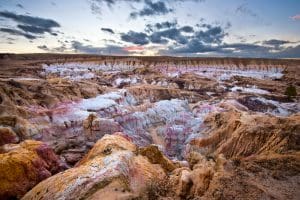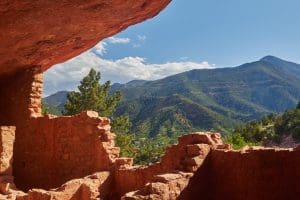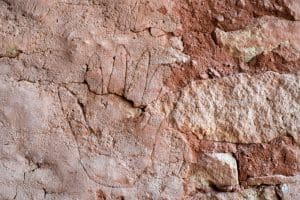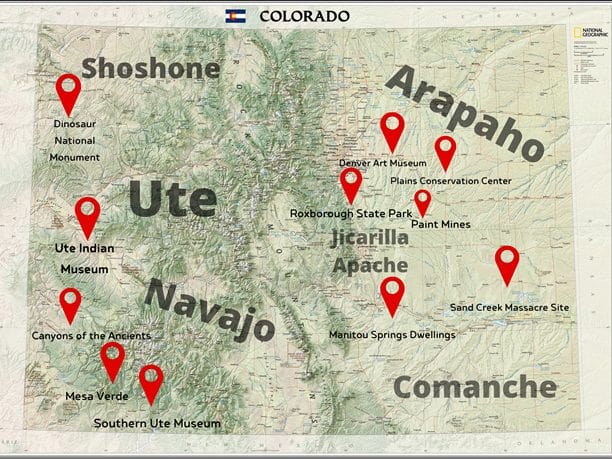Whether you’re a native or you’re new to town, there is always more we can learn about the Indigenous people who once, and still, inhabit Colorado.
Join us, on a tour from East to West as we take you to some of the most captivating and remarkable places in the state.
Places to Visit
Denver Art Museum, opens a new window
Starting up north, we begin our journey in our state capitol, Denver! The Denver Art Museum houses a vast array of over 18,000 pieces of art and artifacts on display year-round in the Indigenous Arts of North America, opens a new window collection.
Plains Conservation Center, opens a new window
Aurora is still home to a diverse population of native plants and wildlife. Visit the Plains Conservation Center for a close-up look at the land, opens a new window that once housed and fed the tribes of Native Colorado. With over 1,000 acres of grasslands and incredible mountain views, see the plains as they once looked hundreds of years ago.
Roxborough State Park, opens a new window
If you love to run, hike, bird watch or look for wildlife, Roxborough State Park’s 4,000 acres is just the place for you. Hosting evidence of human activity as far back as 10,000 years, you’ll find yourself amid the homeland of the Paleo Indians and beyond. Treat this location, like all others on this list, with respect. The Park is home to rich history, opens a new window and invaluable natural wonders.
Paint Mines Interpretive Park, opens a new window

Located in El Paso County, the Paint Mines Park includes some of the most stunning geological formations in Colorado. With 750 acres of land and 4 miles of trails, visit this park to witness evidence of human activity dating back 9,000 years. Due to the fragile nature of this location, pets, horses, bikes and climbing on the formations are prohibited.
Sand Creek Massacre National Historical Site, opens a new window
On the morning of November 29, 1865, 675 cavalrymen led by Colonel John Chivington attacked a camp of Cheyenne and Arapahoe people. The eight-hour massacre, opens a new window resulted in the death of 250 Indigenous people, many of which were women, children and elders. The site was finally dedicated and opened to the public in 2007. The location is still mostly comprised of prairie land, but does contain a visitor contact station and bookstore, in addition to locations for visitors to picnic.
Manitou Springs Cliff Dwellings, opens a new window

Visit the homes of the Ancestral Puebloans (formerly referred to as Anasazi, opens a new window), who inhabited these lands as far back as 1200 B.C. Now a privately owned tourist attraction, the Manitou Cliff Dwellings offer visitors a look into the homes of the original people of this land, as well as museums, gift shops and educational opportunities.
, opens a new windowDinosaur National Monument and Petroglyphs, opens a new window
While Dinosaur National Monument was made famous by the ancient remains of fossilized dinosaurs, a mere 1,000 years ago the area was the home to the Fremont people, opens a new window. They left their mark on the land in the form of petroglyphs and pictographs that can still be seen today. Straddling the Colorado-Utah border, Dinosaur National Monument has a wealth of history and science to explore, but don’t touch the art, pictographs and petroglyphs as they are very fragile.
Ute Indian Museum, opens a new window
Located in picturesque Montrose County, the Ute Indian Museum offers programs, events and activities for all ages. Learn about local archaeological discoveries, visit the historic land of Chief Ouray, opens a new window—pronounced “Yur-ay"—or schedule a virtual field trip!
Canyons of the Ancients, opens a new window

Located in the four corners region of the state, Canyons of the Ancients is truly a sight to behold. 167,000 acres of federal land is home to the highest concentration of archaeological site density in the United States. Remnants of past inhabitants can be found in over 30,000 locations across this national monument.
Before you go, please know that touching, moving or collecting artifacts, opens a new window, arrowheads, plant matter or leaving your permanent mark on any site is illegal. For more information, check out this article on the National Park Service website, opens a new window.
Mesa Verde, opens a new window
Perhaps one of the most famous landmarks in Colorado, Mesa Verde offers visitors a look into a site first occupied by the Pueblo people over 700 years ago. See geological formations, cliff dwellings, opens a new window and artifacts from 26 tribes. This majestic landscape offers camping, hiking, educational opportunities and even a book store!
Southern Ute Museum, opens a new window
Located in the heart of the Southern Ute Reservation, this museum is owned and operated by the tribe itself. Offering a unique and personal perspective of the heritage of the Southern Ute tribe, this museum is a must see. Support this museum and help the Southern Ute tribe thrive and survive.
Know Before You Go
While you’re exploring our beautiful state, be sure to check out library resources including State Parks passes and FREE tickets to local museums and attractions! Also, check each park website for information about closures and precautions.
Additional Information About Colorado Tribes
Check out more resources by, for and about Indigenous peoples living in Colorado, opens a new window.



Add a comment to: Discover Native Colorado